Australia Oil and Gas Market Size
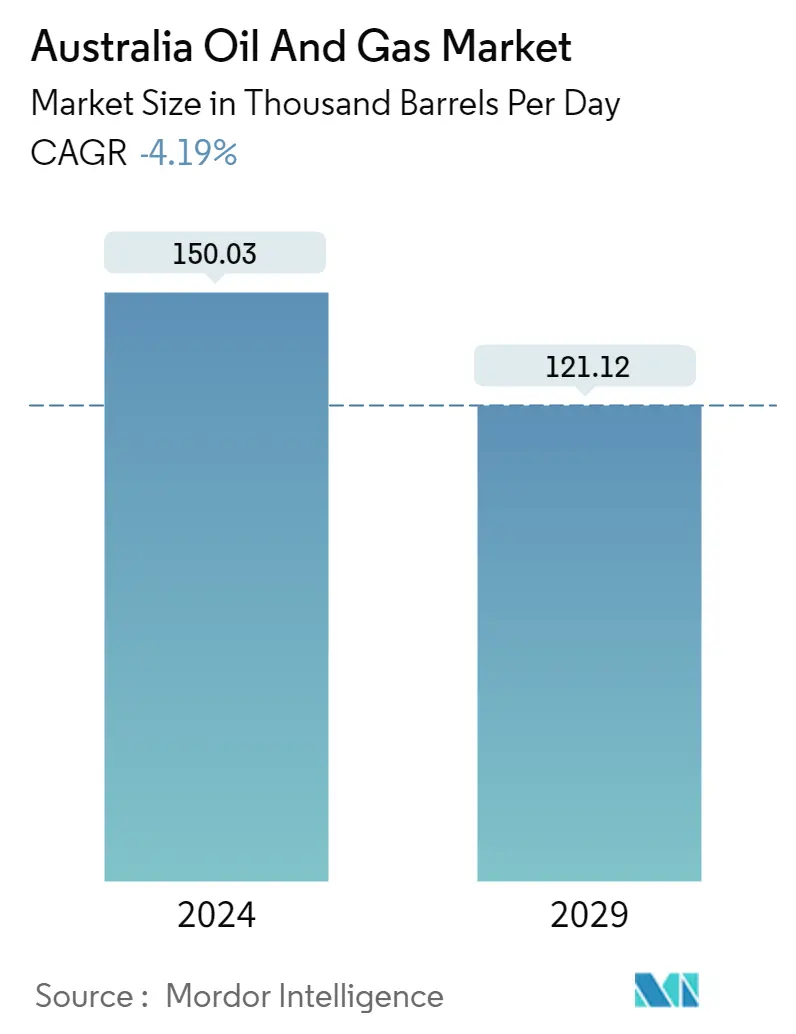
| Study Period | 2020 - 2029 |
| Base Year For Estimation | 2023 |
| Forecast Data Period | 2024 - 2029 |
| Historical Data Period | 2020 - 2022 |
| CAGR (2024 - 2029) | -4.19 % |
| Market Concentration | Medium |
Major Players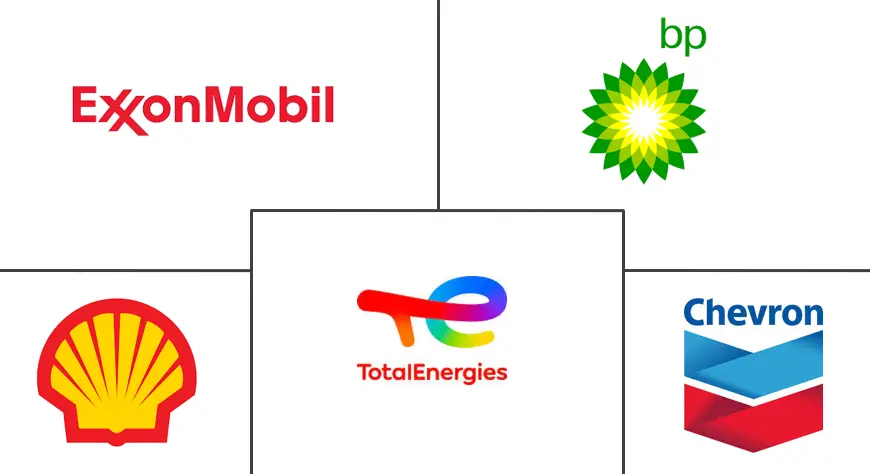
*Disclaimer: Major Players sorted in no particular order |
Australia Oil and Gas Market Analysis
The Australia Oil And Gas Market size is estimated at 150.03 Thousand barrels per day in 2024, and is expected to decline to 121.12 Thousand barrels per day by 2029.
- Over the medium term, factors such as increasing demand for natural gas and related infrastructural developments are expected to drive the Australian oil and gas market during the forecast period.
- However, the country's shift toward renewable energy, dropping refining capacity, and closure of crude oil refineries in Australia are expected to restrain the market during the forecast period.
- Nevertheless, digitalization in the oil and gas industry, including artificial intelligence (AI), machine learning, data analytics, big data, robotics, virtual reality (VR), and automation, is expected to create immense opportunities for Australia in the coming years.
Australia Oil and Gas Market Trends
Midstream Segment Expected to Witness Significant Demand
- The midstream oil and gas sector covers transporting and storing crude oil, natural gas, and refined products. In its unrefined state, crude oil is transported by two primary modes: tankers, which travel interregional water routes, and pipelines, through which most of the oil moves for at least part of the route. After oil extraction and natural gas separation, pipelines transport the products to another carrier or directly to a refinery. Petroleum products then travel from the refinery to market by tanker, truck, railroad car, or more pipelines.
- Crude oil, natural gas liquids, and their products are transported from the production facilities to an offsite temporary storage plant and then transported to a large storage hub for refining. Once refined, the end products of crude oil, such as LPG, jet fuel, gasoline, and diesel, are transported to the residential sector, industrial users, gas stations, storage terminals, etc.
- According to the Australian Pipelines and Gas Association, in 2021, Australia had more than 4000 km of natural gas transmission pipelines that efficiently transport gas under high pressure from where it is produced on the outskirts of cities. According to Australian Petroleum Statistics, natural gas production in Australia increased from 110.1 billion cubic meters in 2017 to 147.2 billion cubic meters in 2021. Australia's gas consumption increased by 15%, from 37.1 billion cubic meters in 2017 to 39.4 billion cubic meters in 2021. The increased production is anticipated to boost the growth of the pipeline infrastructure in Australia.
- In May 2022, construction started on a 580-kilometer, USD 460 million pipeline in Western Australia that will take natural gas from the Perth basin to resource projects in the state's Goldfields.
- The country is one of the top exporting of liquified natural gas (LNG) to various countries such as Japan, China, South Korea, Taiwan, Malaysia, and other countries. In 2022, Australia's total export of LNG was 180.96 million megaliters.
- Therefore, due to these factors, the midstream segment is expected to witness significant growth in the Australian oil and gas market during the forecast period.
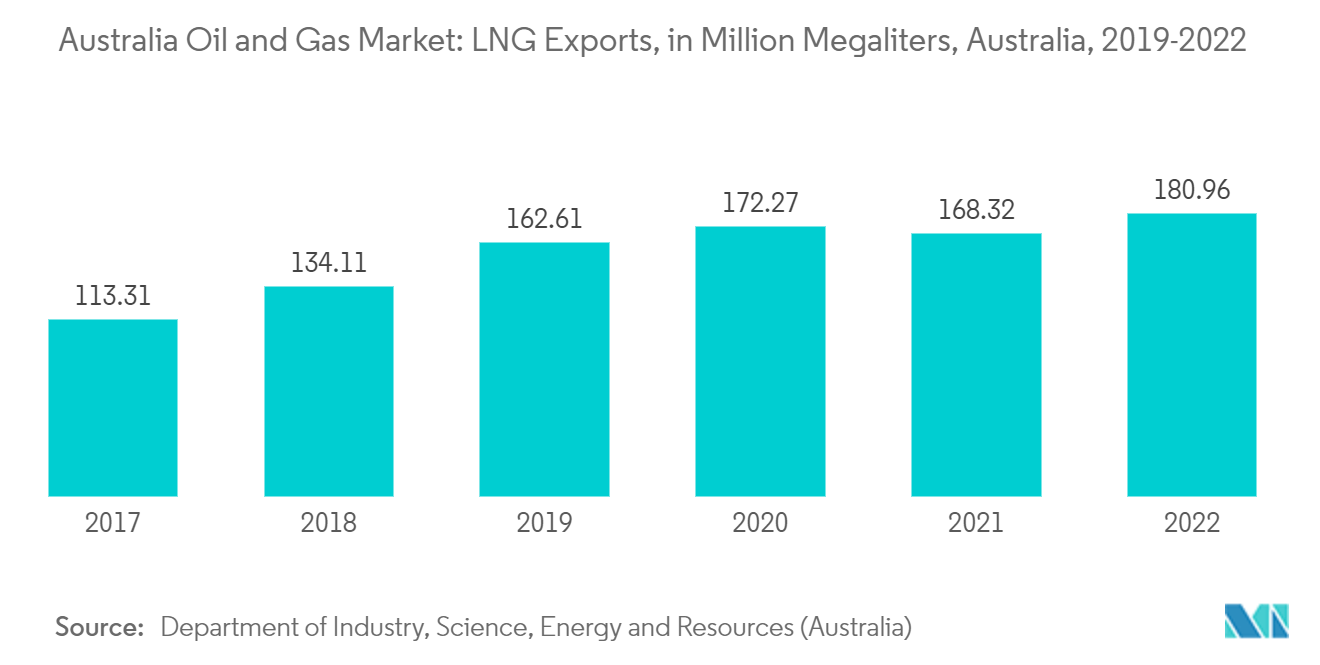
Increasing Demand for Natural Gas and Related Infrastructure Expected to Drive the Market
- The country is significantly sifting towards cleaner sources of energy generation in order to reduce the emission of harmful greenhouse gases in the environment. These cleaner sources of energy generation include natural gases.
- Natural gas has witnessed significant growth in Australia's production and consumption for several years as it is readily available and is a primary energy source for cleaner energy. In 2022, Australia's total natural gas production was 163,360 million cubic meters, which rose from 56,256 million cubic meters in 2011. Further, the country's total gas consumption reached 39.4 bcm in 2021, compared to 32.8 bcm in 2011, recording a 1.9% growth rate between 2011 and 2021.
- The increasing exploration and production of natural gas reserves are mainly driven by rising industrial demand from the refining, petrochemical, particular chemical, and fertilizer industries. Additionally, secure storage helps the industry manage seasonal variations in demand and enhances energy security.
- As part of Australia's gas-fired recovery, the government committed to boosting the entire supply chain's east coast gas market. The government aims to focus on three key areas: unlocking supply, delivering an efficient pipeline and transportation market, and empowering gas customers. Therefore, this factor is expected to increase the demand for gas-based infrastructure in the country.
- In August 2022, Santos Ltd. announced that the company had bought a company that owns an approved underground pipeline route that could transport natural gas from its planned Narrabri project.
- Therefore, owing to such factors, the increasing demand for natural gas and related infrastructure is expected to drive the market during the forecast period.
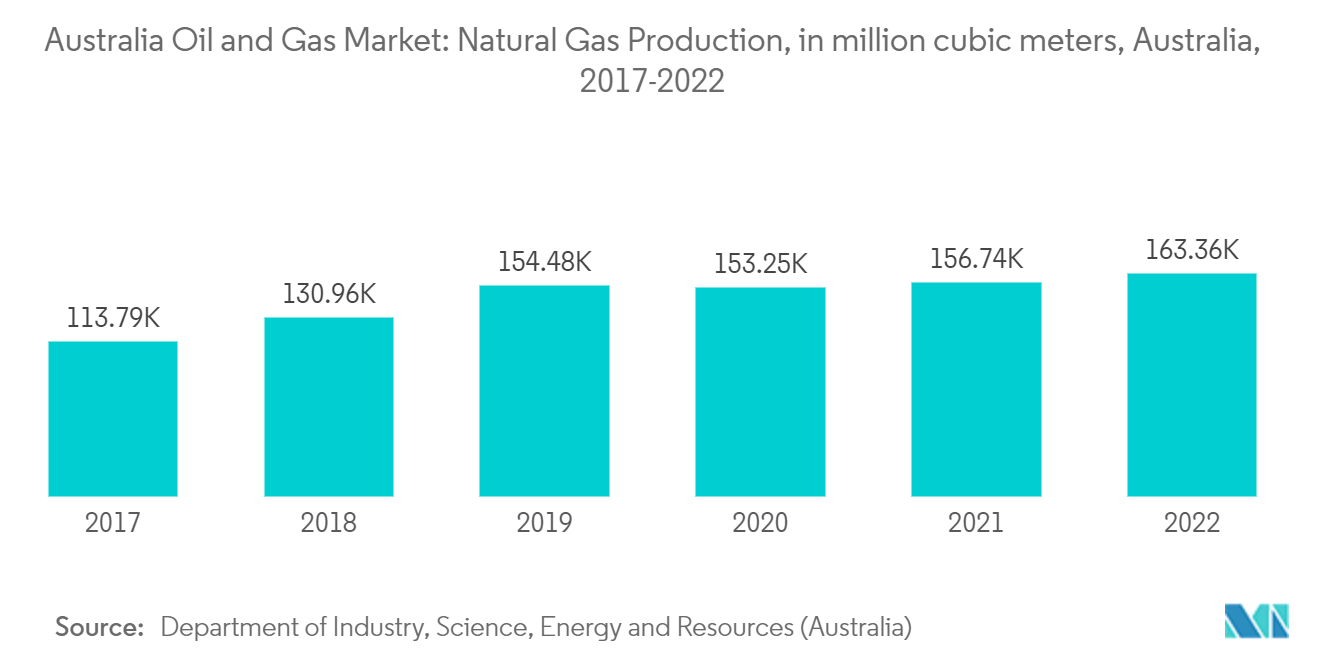
Australia Oil and Gas Industry Overview
The Australian oil and gas market is moderately fragmented. Some of the major companies (in no particular order) include Shell PLC, TotalEnergies SE, Chevron Corporation, ExxonMobil Corporation, and BP PLC., among others.
Australia Oil and Gas Market Leaders
-
TotalEnergies SE
-
Chevron Corporation
-
BP PLC
-
Shell PLC
-
ExxonMobil Corporation
*Disclaimer: Major Players sorted in no particular order
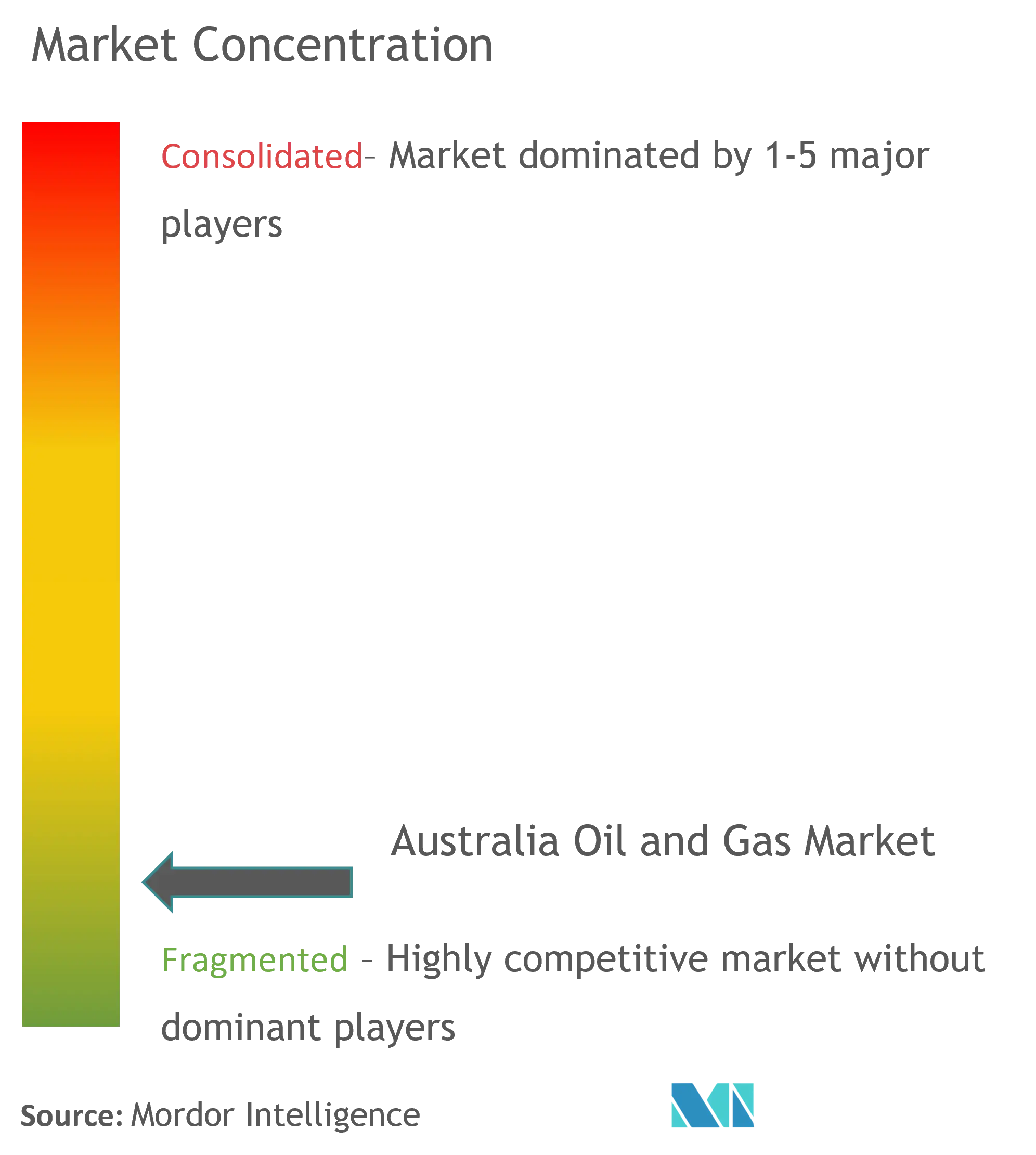
Australia Oil and Gas Market News
- September 2022: Santos Ltd. sanctioned a USD 300 million pipeline project that would create an additional connection to its Darwin liquefied natural gas facility in Northern Australia.
- March 2023: ConocoPhillips announced through its Australian subsidiary that it is planning to become the upstream operator of Australia Pacific LNG (APLNG) following the closing of EIG's transaction with Origin Energy. The company also agreed to purchase up to an additional 2.49% of the shareholding in APLNG. After this transaction, it is expected to own around 49.99% of APLNG.
Australia Oil and Gas Market Report - Table of Contents
1. INTRODUCTION
- 1.1 Scope of the Study
- 1.2 Market Definition
- 1.3 Study Assumptions
2. EXECUTIVE SUMMARY
3. RESEARCH METHODOLOGY
4. MARKET OVERVIEW
- 4.1 Introduction
- 4.2 Oil and Gas Reserves Status in Australia, 2022
- 4.3 Australia Crude Oil and Natural Gas Production Forecast, until 2028
- 4.4 Australia Refining Capacity and Forecast, until 2028
- 4.5 Oil and Gas Industry Investment Trend
- 4.6 Recent Trends and Developments
- 4.7 Government Policies and Regulations
-
4.8 Market Dynamics
- 4.8.1 Drivers
- 4.8.1.1 Increasing Natural Gas Demand
- 4.8.1.2 Rising Pipeline Network and Associated Infrastructure Development
- 4.8.2 Restraints
- 4.8.2.1 Rising Shift toward Renewable Energy
- 4.9 PESTLE Analysis
5. MARKET SEGMENTATION BY SECTOR
- 5.1 Upstream
- 5.2 Midstream
- 5.3 Downstream
6. COMPETITIVE LANDSCAPE
- 6.1 Mergers and Acquisitions, Joint Ventures, Collaborations, and Agreements
- 6.2 Strategies Adopted by Leading Players
-
6.3 Company Profiles
- 6.3.1 Shell PLC
- 6.3.2 TotalEnergies SE
- 6.3.3 Chevron Corporation
- 6.3.4 ExxonMobil Corporation
- 6.3.5 BP PLC
- 6.3.6 Woodside Petroleum Limited
- 6.3.7 BHP Group PLC
- *List Not Exhaustive
7. MARKET OPPORTUNITIES AND FUTURE TRENDS
- 7.1 Growing Digitalization in the Oil and Gas Industry
Australia Oil and Gas Industry Segmentation
Oil and natural gas markets are major industries in the energy market and play an influential role in the global economy as the world's primary fuel source. The processes and systems involved in producing and distributing oil and gas are highly complex, capital-intensive, and require state-of-the-art technology.
The Australian oil and gas market is segmented by sector into upstream, midstream, and downstream. The market sizing and forecasts have been done based on volume (thousand barrels per day).
Australia Oil and Gas Market Research FAQs
What is the current Australia Oil And Gas Market size?
In 2024, the Australia Oil And Gas Market size is expected to reach 150.03 thousand barrels per day.
Who are the key players in Australia Oil And Gas Market?
TotalEnergies SE, Chevron Corporation, BP PLC, Shell PLC and ExxonMobil Corporation are the major companies operating in the Australia Oil And Gas Market.
What years does this Australia Oil And Gas Market cover, and what was the market size in 2023?
In 2023, the Australia Oil And Gas Market size was estimated at 156.59 thousand barrels per day. The report covers the Australia Oil And Gas Market historical market size for years: 2020, 2021, 2022 and 2023. The report also forecasts the Australia Oil And Gas Market size for years: 2024, 2025, 2026, 2027, 2028 and 2029.
What are the primary segments of the Australia Oil and Gas Market?
The primary segments of the Australia Oil and Gas Market are a) Type: Upstream, Midstream and Downstream b) Drilling Type: Onshore and Offshore c) Application: Institutions, Residential and Commercial
Australia Oil and Gas Industry Report
The Australian oil and gas market is poised for steady growth, driven by increasing demand for natural gas and significant infrastructural developments. The market is segmented into upstream, midstream, and downstream sectors, with the midstream segment, which includes transportation and storage of crude oil, natural gas, and refined products, expected to witness substantial growth. This growth is bolstered by efficient pipeline infrastructure and the country's prominent status as a leading exporter of liquefied natural gas (LNG). Additionally, the shift towards cleaner energy sources, particularly natural gas, to reduce emissions is a key trend shaping the oil and gas industry in Australia.
Onshore and offshore drilling activities play crucial roles in tapping into the country's substantial oil and gas reserves, contributing significantly to both domestic consumption and export activities. The market's outlook is positive, supported by advancements in digitalization and technology within the industry. Oil and gas companies in Australia are focusing on leveraging these trends to drive growth and maintain a competitive edge in the global market. Statistics for the Australia oil and gas market share, size, and revenue growth rate, created by Mordor Intelligence™ Industry Reports, provide a comprehensive analysis.
The Australia oil and gas analysis includes a market forecast outlook and historical overview. Get a sample of this industry analysis as a free report PDF download. The industry's growth rate is influenced by various factors, including market data and market segmentation. Industry analysis and industry information play significant roles in understanding the market trends and market predictions. The market forecast and market growth are essential for planning and strategic decisions. Industry outlook and industry reports provide insights into the future of the market.
Industry research and industry sales data are crucial for assessing market value and market leaders. Market overview and market review offer a comprehensive understanding of the sector. The industry's size and statistics help in evaluating market performance. Industry trends and market outlook are vital for anticipating changes in the market. Report examples and report PDFs are useful resources for detailed analysis. Research companies contribute to the depth of industry analysis and market predictions.



